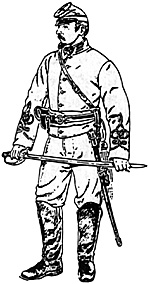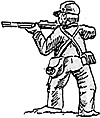 Another discovery, from my archive in the loft. I found them and decided to try them out again. This is just another of the exercises from years ago where the aim is really to just provide a quick game. Since my figures and terrain tiles are a constant, this uses some of same basics as ACW Solo Exercise which appeared in LW126.
Another discovery, from my archive in the loft. I found them and decided to try them out again. This is just another of the exercises from years ago where the aim is really to just provide a quick game. Since my figures and terrain tiles are a constant, this uses some of same basics as ACW Solo Exercise which appeared in LW126.
So now let me deal with the basics and the mandatory bits.
SCALES 15mm figures. Ground scale 1 inch represents 50 yards. Game turn represents 15 minutes. 6mm figures Ground scale 1 centimetre represents 50 yards. Game turn represents 15 minutes.
MAP This is a piece of A4 paper with a grid 4" by 6" and the squares are numbered left to right top to bottom 1 - 24. This represents your games table of 4' by 6' or 48 centimetres by 72 centimetres. The top of the grid is North and the Bottom is South. On this you draw the terrain, which, of course, you can randomly generate if you wish. You can include woods, rivers, etc. but you must have the following mandatory items.
MANDATORY A good dirt road or a track must run the length of the table. A simple cut of a card deck can tell you which it is, Red is the track and Black a good dirt road. Now roll 1D6:
- 1 - Road runs south from square 1 diagonally to square 24.
2 - Road runs south from square 2 diagonally to square 23.
3 - Road runs south from square 3 diagonally to square 22.
4 - Road runs south from square 4 diagonally to square 21.
5 - Road runs straight south from square 2 to square 22.
6 - Road runs straight south from square 3 to square 23.
Using the deck of cards assign the values 9 for hearts, 13 for clubs, 17 for diamonds and 21 for spades, cut the deck. When you cut the deck this will designate where the intersecting road comes on to the table from west to east. The same card cut can of course decide if it's a good dirt road or a track.
GAME TIME The game will last a maximum of fifteen turns.
OBJECTIVE Your objective is to hold the crossroads for the duration of the game.
START POINT Using the deck of cards assign the values 1 for hearts, 2 for clubs, 3 for diamonds and 4 for spades, cut the deck. This will designate your current position.
YOUR FORCE Your force consists of:
- Infantry Regiment of [1D6 +1 x 100]
- Rating determined by 1D6 as: Green 1,6 Veteran 2 Seasoned 3,4,5
Cavalry Detachment of [1D6 + 1 x 10]
- Rating determined by 1D6 as: Green 1,5 Seasoned 2,3,4 Veteran 6
1 section of Artillery - 2 x 12lb Napoleons Veteran
Supply wagons x 2. 4 horse teams. Green
All troops have rations for 1 day. Infantry and cavalry have 40 rounds per man. Artillery has ammunition of 30 solid shot, 30 percussion, 40 canister rounds per gun. There are forage supplies for 2 days for all horses in one supply wagon. The other contains rations and ammunition. Suggest a 1D6 roll to decide how much of each.
Now your force is fixed and will not be reinforced. Your Objective is as clear or at least as clear as it gets.
MOVEMENT TABLE [Inches for 15mm or cm for 6mm].
| UNIT TYPE: | Infantry | Cavalry | Supply Wagons | Artillery | Horse Artillery |
|---|---|---|---|---|---|
| Turnpike | 18 | 30 | 16 | 18 | 24 |
| Road | 14 | 25 | 12 | 16 | 22 |
| Track | 11 | 16 | 8 | 13 | 14 |
| X-Country | 6 | 11 | 4 | 7 | 9 |
GAME TURN Each turn you get the privilege of going first. All you have to do is decide where and how far to move your force. You may choose to scout with the cavalry, throw out a wide skirmish line of infantry or just take the whole column en-masse down the road. Whatever you choose to do, you are the commander, it's your decision and you have to live with the consequences.
Then it's the enemy turn. Roll 1D6. 1,2,5,6 means there is enemy present so now cut the deck of cards and apply the following:
 CARD DESCRIPTION
CARD DESCRIPTION
Red Ace – Queen. Place a ? marker in square 1 - 12.
Black Ace – Queen. Place a ? marker in square 13 - 24.
King. False alarm still nobody there. [Note markers can be scraps of cards - tiddlywinks, pins or match sticks whatever you choose] When you arrive in a square which contains a marker, or, when a marker arrives in a square with you then: Roll 1D6.
- 1,6 means the enemy sees you and you see him, and he is entrenched.
2,5 means the enemy sees you and you see him, but he is not entrenched.
3,4 means you see the enemy and he has not seen you, so he will take a turn to deploy
Roll 1D6. Cut the card deck this many times. Turn over each of the decks and apply the following:
CARD DESCRIPTION
Red Ace, 2 - Artillery sections each of 2 x 12lb Napoleons
Red 3 –10. Number of Infantry companies of 100 men with a rating of Green
Red J,Q,K. Ten Infantry companies of 80 men with a rating of seasoned.
Black Ace, 2 - Horse Artillery sections each of 2 x 3" Rodman Rifles
Black 3 –10. Number of Cavalry companies of 80 men with a rating of Green
Black J,Q,K. Ten companies of 60 men with a rating of seasoned.
Now you decide whether you wish to run or fight. If you run, the enemy will follow you: Roll 1D6.
- DIE ROLL DESCRIPTION
1,2 - Immediate pursuit. Full move if not entrenched. Half move if entrenched.
3,4 - Delay. Only two thirds move if not entrenched. Quarter move if entrenched.
5,6 - Only manage half distance move if not entrenched. No movement if entrenched.
Once the initial enemy move has been made the enemy will pursue to the maximum infantry move on each subsequent turn that follows until you decide to stand and fight or conversely the enemy catches you and forces the fight. If you and the enemy enter another square with a marker then this force is automatically alerted. Cut the cards as before for the type and number of units. This force immediately joins in the pursuit. If you decide to fight then use the rules of your choice to decide the outcome. For these exercises I assumed, for simplicity that if the enemy force was larger it attacked, if equal or smaller then it defended. Feel free to use other solo mechanisms at this point if you wish. The time limitation of 15 turns includes the turns for the battle too and makes this little exercise harder than it looks. Your force is fixed and so is the objective but the enemy is random in size, type and location. He can land on top of your supply train, in your rear, on your flank, be at the crossroads before you, be a few companies, a whole regiment or even a brigade, anything is possible.
If you have more time, then increase the number of turns but it might not make it easier. As always it is solely up to you to make all of the decisions; you're the Soloist. The most important thing is to have FUN and enjoy the hobby.
Back to Table of Contents -- Lone Warrior #131
Back to Lone Warrior List of Issues
Back to MagWeb Magazine List
© Copyright 2000 by Solo Wargamers Association.
This article appears in MagWeb (Magazine Web) on the Internet World Wide Web.
Other military history articles and gaming articles are available at http://www.magweb.com
